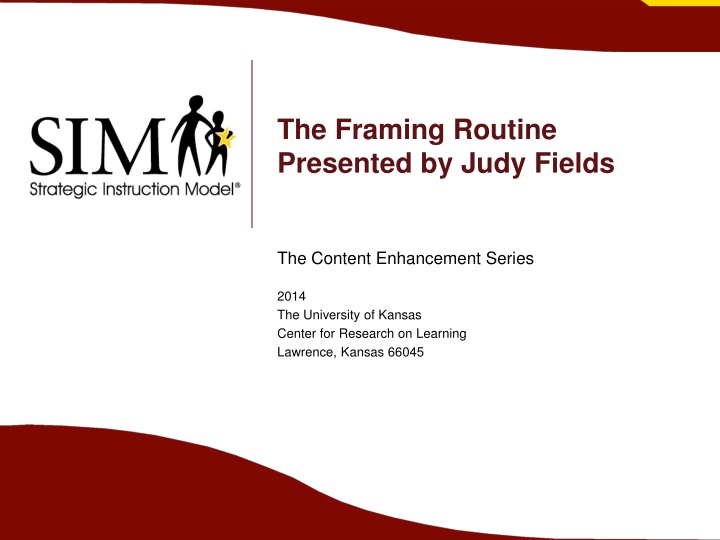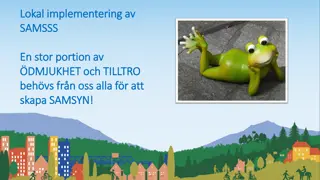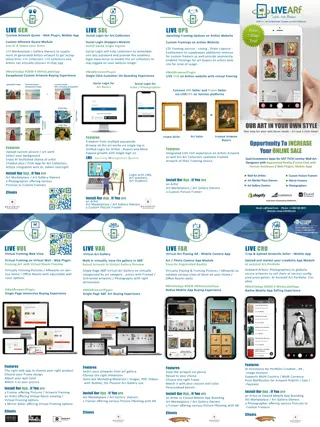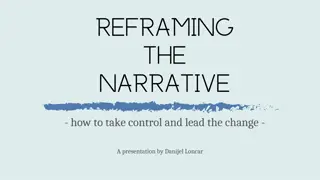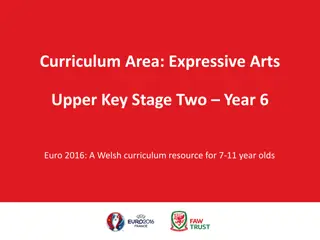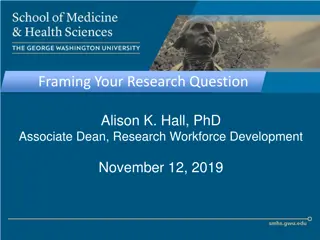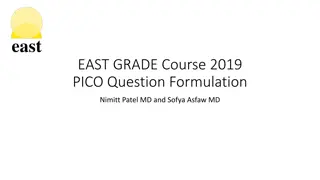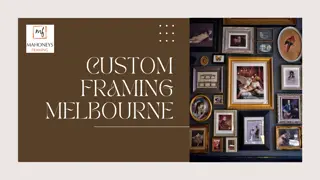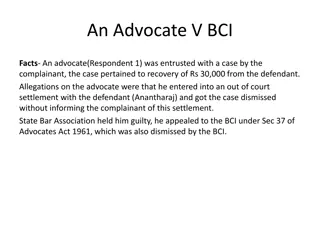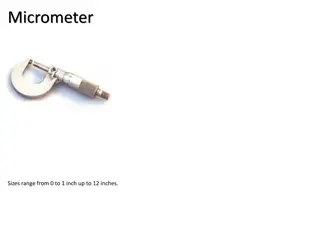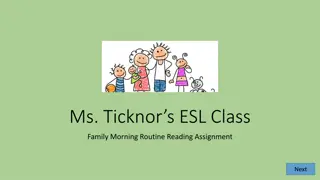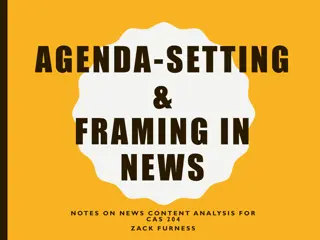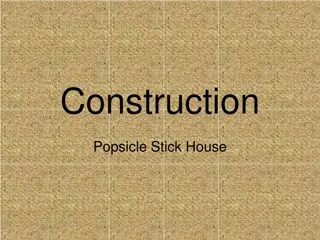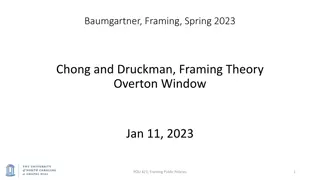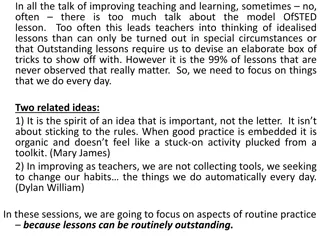The Framing Routine - Teaching Diverse Students
The Framing Routine, presented by Judy Fields, is a method to help students grasp key information and understand the relationships between main ideas and details. It aims to support inclusive teaching and enhance student learning outcomes, particularly in diverse classrooms. The routine has been studied extensively and has shown significant improvements in student learning gains, writing fluency, and overall comprehension in intermediate and secondary classes. Teachers who implement the Framing Routine with proper training and regular use have observed positive results in student performance.
Download Presentation

Please find below an Image/Link to download the presentation.
The content on the website is provided AS IS for your information and personal use only. It may not be sold, licensed, or shared on other websites without obtaining consent from the author.If you encounter any issues during the download, it is possible that the publisher has removed the file from their server.
You are allowed to download the files provided on this website for personal or commercial use, subject to the condition that they are used lawfully. All files are the property of their respective owners.
The content on the website is provided AS IS for your information and personal use only. It may not be sold, licensed, or shared on other websites without obtaining consent from the author.
E N D
Presentation Transcript
The Framing Routine Presented by Judy Fields The Content Enhancement Series 2014 The University of Kansas Center for Research on Learning Lawrence, Kansas 66045
Content Enhancement A way of teaching an academically diverse group of students in which Both group and individual needs are valued and met; The integrity of the content is maintained;Critical features of the content are selected and transformed in a manner that promotes student learning; Critical features of the content are selected and transformed in a manner that promotes student learning; and Instruction is carried out in a partnership with students. 2 University of Kansas Center for Research on Learning 2014
The Challenge Increased student diversity results in varying skill levels and types of background knowledge. Today s classrooms are very diverse! Most students have difficulty distinguishing between major concepts, main ideas, and details. Most students have difficulty distinguishing between essential-to-know information and trivia. 3 University of Kansas Center for Research on Learning 2014
Supporting Research The Framing Routine was studied in intermediate and secondary classes (grades 4-12) characterized by diversity. In each study, teachers learned the routine easily, and student learning gains were observed by teachers and researchers. Students gained an average of 10 to 15 percentage points on tests or tasks that required demonstration of mastery. Students writing fluency increased dramatically. Students wrote an average of 96 more words on post- test writing tasks; ideation was significantly more coherent; mechanical errors reduced significantly. 4 University of Kansas Center for Research on Learning 2014
Supporting Research Results were achieved when teachers: received 2-3 hours of instruction; discussed the routine with colleagues; spent the necessary time to plan and use the routine for more inclusive teaching; taught students how to use the routine, & used the routine regularly over time. 5 University of Kansas Center for Research on Learning 2014
What is the Framing Routine? A way to help students understand and learn key information. A way to help students focus on the relationships between main ideas and details. 6 University of Kansas Center for Research on Learning 2014
When Do You Use the Routine? Help students organize ideas for writing summaries constructing a plot diagram creating informational text responding to on-demand prompts assimilating content in other subject areas 7 University of Kansas Center for Research on Learning 2014
The Frame Is a visual device that Is used to promote understanding and recall of a key topic and associated essential details. Can be used to take notes about a key topic. Focuses attention on the importance behind the key topic. Identifies the main ideas related to the key topic, essential details behind each main idea, and a summary of what s important to remember about the key topic. 8 University of Kansas Center for Research on Learning 2014
Components of The Framing Routine The Frame The Linking Steps The Cue-Do-Review Sequence 9 University of Kansas Center for Research on Learning 2014
Key Topic The FRAME Routine is about Main idea Main idea Main idea Essential details Essential details Essential details So What? (What s important to understand about this?) 10 University of Kansas Center for Research on Learning 2014
Key Topic The FRAME Routine Progressive Era is about a period of social change in the U. S. Main idea Social Problems Main Main idea Tools for Social Change idea Social Changes Essential details Essential details Essential details Muckrakers wrote about problems Unsafe food Meat Inspection Act Bully pulpits forced new laws Monopolies Anti- trust Act Unsafe and unfair working conditions Activists organized protests Commerce and Labor Departments Demonstrators created public pressure Voting rights expanded Limited voting rights So What? (What s important to understand about this?) To really create social change, many people have to be organized, outspoken, and persistent! 11 University of Kansas Center for Research on Learning 2014
Key Topic The FRAME Routine Progressive Era is about a period of social change in the U. S. Main idea Social Problems Main Main idea Tools for Social Change idea THE KEY TOPIC Social Changes Essential details The name of the key topic being studied. Essential details Essential details Muckrakers wrote about problems Unsafe food Meat Inspection Act Bully pulpits forced new laws Monopolies Anti- trust Act Unsafe and unfair working conditions Activists organized protests Commerce and Labor Departments Demonstrators created public pressure Voting rights expanded Limited voting rights So What? (What s important to understand about this?) To really create social change, many people have to be organized, outspoken, and persistent! 12 University of Kansas Center for Research on Learning 2014
Key Topic The FRAME Routine Progressive Era is about a period of social change in the U. S. Main idea Social Problems Main Main idea Tools for Social Change idea Social Changes Essential details Essential details IS ABOUT STATEMENT Essential details Muckrakers wrote about problems A brief explanation of what the key topic is about. Unsafe food Meat Inspection Act Bully pulpits forced new laws Monopolies Anti- trust Act Unsafe and unfair working conditions Activists organized protests Commerce and Labor Departments Demonstrators created public pressure Voting rights expanded Limited voting rights So What? (What s important to understand about this?) To really create social change, many people have to be organized, outspoken, and persistent! 13 University of Kansas Center for Research on Learning 2014
Key Topic The FRAME Routine Progressive Era is about a period of social change in the U. S. Main idea Social Problems Main Main idea Tools for Social Change idea Social Changes Essential details Essential details Essential details Muckrakers wrote about problems Unsafe food Meat Inspection Act MAIN IDEAS Bully pulpits forced new laws Monopolies The main ideas behind the key topic. Can be subtopics or brief phrases representing components of the key topic or items that are sequentially related to each other and the key topic. The actual number of main ideas may vary. Anti- trust Act Unsafe and unfair working conditions Activists organized protests Commerce and Labor Departments Demonstrators created public pressure Voting rights expanded Limited voting rights So What? (What s important to understand about this?) To really create social change, many people have to be organized, outspoken, and persistent! 14 University of Kansas Center for Research on Learning 2014
Key Topic The FRAME Routine Progressive Era ESSENTIAL DETAILS is about a period of social change in the U. S. Details that are essential for students to know and remember about each main idea. Main idea Social Problems Main Main idea Tools for Social Change idea Social Changes Essential details Essential details Essential details Muckrakers wrote about problems Unsafe food Meat Inspection Act Bully pulpits forced new laws Monopolies Anti- trust Act Unsafe and unfair working conditions Activists organized protests Commerce and Labor Departments Demonstrators created public pressure Voting rights expanded Limited voting rights So What? (What s important to understand about this?) To really create social change, many people have to be organized, outspoken, and persistent! 15 University of Kansas Center for Research on Learning 2014
Factors to Consider When Selecting Essential Details Importance Which details are so important that all students must understand them if they are to understand the main idea. Frequency Which details are referred to frequently in class? Interest Which details are important enough to know, but may not seem very interesting to students and therefore require special attention? 16 University of Kansas Center for Research on Learning 2014
Factors to Consider When Selecting Essential Details Preparation Which details are foundations for information that will be covered later in the course and encountered later in life? Complexity Which details are difficult to understand because of their complexity? 17 University of Kansas Center for Research on Learning 2014
Key Topic The FRAME Routine Progressive Era is about a period of social change in the U. S. SO WHAT? Main idea Social Problems Main Main idea Tools for Social Change idea OR WHAT S IMPORTANT TO UNDERSTAND ABOUT THIS? Social Changes Essential details Essential details Essential details Muckrakers wrote about problems Unsafe food Meat Inspection Act A statement designed to help students understand: Bully pulpits forced new laws Monopolies how the current topic is related to the overall unit. how the topic can be used to solve or understand a real-world problem. Anti- trust Act Unsafe and unfair working conditions Activists organized protests Commerce and Labor Departments Demonstrators created public pressure Voting rights expanded Limited voting rights So What? (What s important to understand about this?) To really create social change, many people have to be organized, outspoken, and persistent! 18 University of Kansas Center for Research on Learning 2014
Determine the So What? Importance Statement May be Basic summary Topical applications or implications Generative, or basic life truth MUST be in the student s own words 19 University of Kansas Center for Research on Learning 2014
The Purpose of the Linking Steps Guide the teacher to Present the information in the Frame to students in an effective manner. Involve students in constructing the Frame. Focus student attention on learning. 20 University of Kansas Center for Research on Learning 2014
The Linking Steps Focus on the topic Reveal main ideas Analyze details Make a So What? Statement Extend understanding 21 University of Kansas Center for Research on Learning 2014
Options for Extending* Understanding Prioritize main ideas and essential details according to importance. Prioritize main ideas according to other criteria (e.g., Which had the greatest impact on their lives? Which were the most controversial? Which were the most misunderstood?). Since the E step does not appear on the device, how will you remember to engage students in this step? 22 University of Kansas Center for Research on Learning 2014
Options for Extending Understanding Speculate what might have happened under a different set of circumstances. Forecast what happened next. Connect how main ideas relate to each other information previously learned past experiences the real world 23 University of Kansas Center for Research on Learning 2014
The Cue-Do-Review Sequence Cue Students that the routine will be used. Do The routine. Review The information and process. 24 University of Kansas Center for Research on Learning 2014
The Cue-Do-Review Sequence Cue A visual device called the Frame is presented and explained to students as a way to help them understand how critical information is organized. 25 University of Kansas Center for Research on Learning 2014
The Cue-Do-Review Sequence Do During the initial presentation, the teacher follows a set of procedures called the Linking Steps that help the teacher explain how the Frame will enhance learning. 26 University of Kansas Center for Research on Learning 2014
The Cue-Do-Review Sequence Review The teacher uses the Frame to check and bolster student understanding of the topic. 27 University of Kansas Center for Research on Learning 2014
Get Ready Decide when to use the Framing Routine. Collect materials and ideas. Construct a draft of the Frame. Plan for the presentation. 28 University of Kansas Center for Research on Learning 2014
Get Set Choose material. Preview the lesson. Introduce the Frame. Explain and show how you will Cue the routine. Explain and show how you will Do the routine. Explain and show how you will Review and debrief. 29 University of Kansas Center for Research on Learning 2014
GO The Instructional Sequence We DO It Ya ll DO It You DO It 30 University of Kansas Center for Research on Learning 2014
GO Use the routine explicitly. Build thinking skills. Build in continuity by referring to Frames. Evaluate your use of the routine. Teach students to construct their own Frames. Vary your use of the routine. 31 University of Kansas Center for Research on Learning 2014
Develop Your Ensurance Policy Enlist help and feedback from students. Collaborate with a colleague in learning and using the routine. Set aside time to reflect and plan every day. Monitor your growth by regularly noting your thoughts, ideas, and reactions. 32 University of Kansas Center for Research on Learning 2014
Potential Pitfalls "Frames don t have to be prepared before class. Students don t need to be involved in constructing the Frame. If I don t get it right the first time, I won t ever get it right. Students will automatically see the advantages of organizing information using a Frame. 33 University of Kansas Center for Research on Learning 2014
Key Topic The FRAME Routine What motivated Columbus? is about Why did Columbus cross the Atlantic Ocean? Main Main Main Financial Reasons idea Religious Reasons idea Egotistical Reasons idea Essential details Essential details Essential details ! ! ! ! Get rich by selling spices at home Prove God would protect him & not let him die Be the first to prove the world was round ? ? ! ! Get rewarded for successfully making trip Make his sailors get religion when scared ? ? ? Win favor with royalty Spread Christianity to other parts world ? ? ? ! Gain respect Get rich by claiming discovered land as his Become part of the royal court ? ? So What? (What s important to understand about this?) We predict that most of Columbus reasons were egotistical and perhaps financial. 34 University of Kansas Center for Research on Learning 2014
Key Topic The FRAME Routine French Revolution is about a war that resulted from a bad social situation Main Main Main Know already idea Expect to learn idea Want to know idea Essential details Essential details Essential details Two classes (super rich & very poor) Effects on other countries Famous battles Many poor imprisoned in Bastille for no reason Effects on king and family Leaders of both sides Violent; Effects on French people Timeline of events used guillotine a lot Outcome Connection to us Let them eat cake So What? (What s important to understand about this?) Our major interests focus on the effects of this war. 35 University of Kansas Center for Research on Learning 2014
Key Topic The FRAME Routine Cuban Missile Crisis is about A political crisis that nearly led to nuclear war with USSR Main idea Main idea Main idea Castro comes to power in Cuba Bay of Pigs Invasion Nuclear face off with USSR Essential details Essential details Essential details Unfair govt overthrown in Cuba by Castro and followers TE Both US & USSR wanted Cuba as a state F CIA planned an invasion of Cuba TE JFK sent US Air Force to support invasion F US spy plane that spotted missile sites on Cuba flies higher than any other plane Tt Castro got no support from U. S. F JFK entertained dinner guests on night of Invasion Tt Castro nationalized US-owned businesses TE JFK blockaded Cuba to keep out more USSR ships and weapons TE 20,00- Cuban troops beat 1,400 invaders TE Castro smokes Cuban cigars Tt Castro got missiles from USSR TE Castro told USSR not to send weapons F USSR agreed to remove missiles TE So What? (What s important to understand about this?) Because Cuba is so close to US, JKF should have tried to make it a US state. 36 University of Kansas Center for Research on Learning 2014
Key Topic The FRAME Routine Sinking of the Titanic is about an event that taught lessons about... Main idea Main idea Main idea Lack of planning Class system Competition Essential details Essential details Essential details 1- steel hull too thin & Rich Largest ship = more -upper deck (luxury) Fastest speed to break record crossing; unable to Not enough Middle -middle decks Inattentive about Lower class - More luxury = less Lack of procedures for Broadest decks = fewer So What? (What s important to understand about this?) A great its values and practices so improvements can be made. can cause society to examine 37 University of Kansas Center for Research on Learning 2014
Key Topic The FRAME Routine Pressuring govts. is about how people can put pressure on governments to make them change Main idea Main idea Main idea Hungary opens border to Austria Public pressure on East German govt. East German govt. opens borders Essential details Essential details Essential details E. Germans demonstrate after seeing freedom in Hungary E. German govt. no longer in control Hungary a closed country Hungary wants trade with West W. German govt. sup- ports freedom movement E. German govt. could save face or lose face Hungary ignores Warsaw Pact; opens borders Fleeing E. Germans seen as political refugees E. German govt. decides to allow free movement 1000s of E. Germans leave thru Hungary E. German govt. looks bad in eyes of world So What? (What s important to understand about this?) If there is enough cooperation among people, and they focus their energies, they can influence what governments do. 38 University of Kansas Center for Research on Learning 2014
Key Topic The FRAME Routine Evolution of Europe is about how European civilization evolved through the ages Main idea Main idea Main idea Main idea The Age of Discovery The Middle Ages The Renaissance The Reformation Essential details Essential details Essential details Essential details Life was either very good or bad; two classes Merchant (middle) class allowed trade specialization Increase in leisure time = more time for exploration Trade increased; new middle class New map making technology & navigating skills Increase in education = more people read Bible themselves Common person uneducated Increase in education & the arts Art focused on religion - very dull colors Artists used woodcuts to spread Protestant ideas Arts focused on humans; very realistic Maps became more real and less fantasy City- states govt. allowed Renaissance to start Pope s weakened power = end of Holy Roman Empire Feudalism type of government Monarchs were able to support explorers So What? (What s important to understand about this?) Stages in history never just occur for no reason key things happen that cause big changes in society. 39 University of Kansas Center for Research on Learning 2014
Key Topic The FRAME Routine Civil Disobedience is about people disobeying laws in order to change unfair laws WHEN THEN BECAUSE people disobey a law in a public & nonviolent way changes in laws are considered and often made media build public awareness and support Essential details Essential details Essential details Disrupting traffic with a protest march Want exciting images to attract audience Voting eligibility laws Focus on violent reactions of police Burning a draft card Open housing laws Sit-ins at a university administration office Create public revulsion to violence Integration laws Blacks sitting at the front of a bus Nondiscriminatory employment laws Create an interest in the issue So What? (What s important to understand about this?) Sometimes breaking a law is necessary in order to draw attention to unfair laws to get them changed. 40 University of Kansas Center for Research on Learning 2014
Key Topic The FRAME Routine Endangered loggerheads is about how beach development is endangering sea turtles + = START WITH ADD THIS RESULTS Turtles bury eggs in sand Beach development & tourists Baby turtles die Essential details Essential details Essential details Sea turtles crawl onto beach & bury eggs Houses and hotels on beaches Baby turtles attracted to bright lights Sun incubates eggs; babies dig out of sand Crawl toward bright lights, away from sea Tourists on the beaches Attracted to movement & glimmer of light on water Street lights, car lights, flashing signs, carnivals Babies get lost, disoriented Crawl toward light to get to the sea & swim away Beach buggies on the beaches Eaten by predators and dehydrated So What? (What s important to understand about this?) IF we don t turn off our lights at night, THEN the loggerhead may become extinct. 41 University of Kansas Center for Research on Learning 2014
Key Topic The FRAME Routine is about Our position: Main idea Main idea Main idea What we ll say They ll probably say How we ll respond Essential details Essential details Essential details So What? (What s important to understand about this?) If Then 42 University of Kansas Center for Research on Learning 2014
Key Topic The FRAME Routine Strategic Learners is about students who use good study plans Main idea Main idea Main idea They think BEFORE They think DURING They think AFTER Essential details Essential details Essential details By organizing books and materials By asking and answering questions By thinking how new information can be used By setting goals and making plans By linking new info. to background knowledge By evaluating results By scheduling time wisely By looking for patterns By anticipating future needs So What? (What s important to understand about this?) Strategic learners actively and purposefully use smart strategies before, during, and after learning 43 University of Kansas Center for Research on Learning 2014
Key Topic The FRAME Routine exploitation is about taking advantage of someone or something Main idea Main idea Main idea Facts Real- world examples Personal experiences Essential details Essential details Essential details Strong take advantage of weak Colleges make $ from games; players not paid Parents make me do chores for no money Some politicians exploit voters Big kids in lunch room bully me Results in anger Porn & prostitution exploit women My big brother made me clean his room Some factories exploit workers So What? (What s important to understand about this?) Our world would be better if there were no exploitation in it. 44 University of Kansas Center for Research on Learning 2014
Key Topic The FRAME Routine peaceful resistance is about using non- violent ways to protest and change unfair laws or policies Main idea Main idea Main idea ALWAYS SOMETIMES NEVER Essential details Essential details Essential details Is done to draw atten- tion to the problem Reactions to it are violent Should be used just to get your way Addresses an unfair law, practice, or policy Takes several times to work Involves violence or harsh language Involves peaceful tactics Actions receive negative consequences Works if you do it just yourself To be effective, many must participate Make more enemies than friends So What? (What s important to understand about this?) Peaceful resistance can work to change unfair laws, but you need support from others, and you need to plan on it working slowly. 45 University of Kansas Center for Research on Learning 2014
Key Topic The FRAME Routine Polygons is about labeling shapes according to the number of sides Main idea Main idea Main idea Main idea Triangle Quadrilateral Pentagon Hexagon 3 sides 4 sides 5 sides 6 sides 3 angles 4 angles 5 angles 6 angles TRI means 3 QUAD means 4 PENT means 5 HEX means 6 Main idea Main idea Main idea Main idea Octagon Decagon 8 sides 10 sides 8 angles 10 angles OCT means 8 DEC means 10 So What? (What s important to understand about this?) Polygons are closed, flat figures with straight lines for sides. 46 University of Kansas Center for Research on Learning 2014
Key Topic The FRAME Routine is about Main idea Main idea Main idea Essential details Essential details Essential details So What? (What s important to understand about this?) 47 University of Kansas Center for Research on Learning 2014
Key Topic The FRAME Routine is about Main idea Main idea Main idea Essential details So What? (What s important to understand about this?) 48 University of Kansas Center for Research on Learning 2014
Key Topic The FRAME Routine is about Main idea Main idea Main idea Main idea Main idea Main idea Main idea Main idea So What? (What s important to understand about this?) 49 University of Kansas Center for Research on Learning 2014
